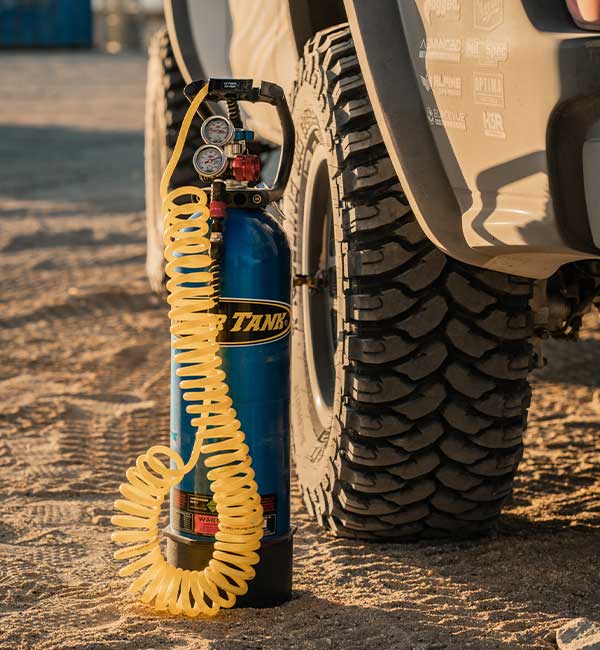Decreasing the air pressure in your tires, also referred to as airing down, is by far the most effective (and least expensive) method to improve your 4×4’s off-road performance. The amount of air you can safely let out of your tires often depends on a number of factors, but even a few pounds can make a significant difference. The two primary reasons to reduce the air pressure in your tires before hitting the trail are to improve tire conformity and ride quality. In this article, we will examine what we have discovered to be the most effective tire pressure for general trail driving.
In a pinch, one can use a pen or key to remove air from a tire valve stem. However, this method is slow and inefficient. A valve core remover tool is a more effective way to deflate a tire, typically reducing the pressure from 30 psi to 7 psi in just a few minutes. It is important to be careful when using a valve core remover tool, as it is easy to lose the valve core. This is why it is a good idea to keep a few spares with you.
Additionally, a high-quality air pressure gauge is a great tool that shows you distinct markings for low pressure. The difference between 14 and 7 PSI in off-road situations is huge. It’s important to make sure air pressure readings are accurate for safety and performance reasons. You can find low pressure gauges at most auto parts stores. However, if finding one is difficult or you forget to bring it with you to the trails, then the tire pressure monitoring system (TPMS) your vehicle is equipped with can come in handy. In most cases, the tire pressure reading can be read either on the dashboard or the settings via the infotainment system.

There is no one-size-fits-all tire inflation number for every truck, but there are some general rules to follow. One of the most important is whether or not your vehicle is equipped with beadlock wheels. If it is, we highly recommend against airing down your tires below 10 PSI. The reason for this is because non-beadlock wheels don’t have a built-in locking mechanism to secure the bead of the tire to the wheel. This can lead to de-beading and is extremely unsafe and dangerous, as well as damaging to the tire or wheel.
We recommend starting at 20 PSI and working down from there. Many factors such as vehicle weight, wheel size, tire diameter, and even terrain will come into play. Based on our experience, on 35” and 37” off-road tires, airing down between 10-12 PSI with non-beadlock wheels is safest. On the other hand, with beadlock wheels, we’ve safely aired down 5-7 PSI. That said, sometimes sand and snow terrain will require lower tire inflation, however the aforementioned are the most common. Keep in mind that these are our experiences, and yours may require different air pressures.
If you are visiting the trails often, it’s wise to invest in a set of beadlock wheels. Unlike standard wheels which use air pressure to keep tires in place, a beadlock wheel uses a mechanism to lock either one or both of the tire beads in place. Having the tires locked securely on the wheels is what makes airing down into single digit air pressure possible. Many tires are constructed with light truck load range D, E and F ratings, so dropping down into the single digits is often necessary to allow sidewall flex.


A good example of off-road performance and tire inflation is to imagine your tire as a basketball. A fully inflated basketball will bounce with little effort. This is because of the high air pressure inside of the ball. In terms of tires, when your tires have road driving air pressures in them, the same basketball analogy applies. Instead of conforming to the terrain, your tires are pushing away from it. This leads to a harsher ride and lack-luster off-road performance. If you let enough air out, the ball will stop bouncing and conform to the ground, the same way a tire would react to the terrain it’s driving on. In the end, this helps the tire grab the terrain by absorbing it, creating a smoother ride, thus increasing handling and performance.
It is important to note that not all tires are created equal and can handle low air pressure abuse off-road. Airing down and off-road driving strain the tire’s tread and sidewall more than normal. If unprepared, you may find yourself on a rugged trail with damaged tires and sidewalls. This is why it’s so important to select the right set of off-road tires for your 4×4 or truck. Having a tire that can handle the abuse of all types of terrain and driving styles, while still maintaining a comfortable ride quality on and off the road is essential. That’s the off-roading experts at RBP suggest the Repulsor M/T and the Repulsor R/T as the go-to choice for serious trail junkies.
In the end, always make sure to be fully prepared before hitting the trail and ensure you have all the equipment you need before you head out. If your rig isn’t equipped with an on-board air compressor, be sure to note where the nearest pump station is. That way you can air up before heading home and avoid safety hazards.
To learn more about off-roading and off-road tires, check out our in-depth tire guide.